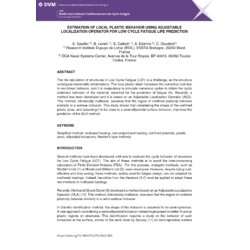- Online only



The life calculation of structures in Low Cycle Fatigue (LCF) is a challenge, as the structure undergoes irreversible deformations. The local plastic strain increases the numerical cost due to non-linear behaviour, and it is compulsory to simulate numerous cycles in order to obtain the cyclic stabilized behaviour of the material, essential for prediction of fatigue life. Several methods have been developed to evaluate the cyclic behaviour, as Neuber’s energetic method [1].
Recently, Herbland [2] and Darlet [3] developed a method based on an Adjustable Localization Operator (ALO) (see "Diagram of ALO's identification" figure). This method, intrinsically multiaxial, assumes that the region of confined plasticity behaves similarly to a semi surface inclusion.
In…

Datenschutzbedingungen (bearbeiten im Modul "Kundenvorteile")

Lieferbedingungen (bearbeiten im Modul "Kundenvorteile")

Rücksendebedingungen (bearbeiten im Modul "Kundenvorteile")
The life calculation of structures in Low Cycle Fatigue (LCF) is a challenge, as the structure undergoes irreversible deformations. The local plastic strain increases the numerical cost due to non-linear behaviour, and it is compulsory to simulate numerous cycles in order to obtain the cyclic stabilized behaviour of the material, essential for prediction of fatigue life. Several methods have been developed to evaluate the cyclic behaviour, as Neuber’s energetic method [1].
Recently, Herbland [2] and Darlet [3] developed a method based on an Adjustable Localization Operator (ALO) (see "Diagram of ALO's identification" figure). This method, intrinsically multiaxial, assumes that the region of confined plasticity behaves similarly to a semi surface inclusion.
In Darlet's identification method, the shape of the inclusion is assumed to be semi-spherical. A new approach considering a semi-ellipsoidal inclusion instead is proposed to better fit actual plastic zones on structures. This identification requires a study on the behaviour of such inclusions at the surface, similar to the work done by Sauzay [4] on semi-spherical surface inclusions.
To assess the capacity of these simplified methods to predict the multiaxial cyclic behaviour of structures, an original specimen is designed. Various multiaxial loading simulations are performed to compare the FEA and the simplified methods. These simulations additionally put forward the relevance of using the new approach for fatigue life prediction. Experimental fatigue tests are also conducted to compare fatigue life predictions, with an in-situ X-ray diffraction stress measurements validation to follow the evolution of the stress range, the mean stress and the crack initiation.
REFERENCES
[1] H. Neuber, Theory of stress concentration for shear-strained prismatical bodies with arbitrary nonlinear stress-strain law, J. Appl. Mech. 28 (4) (1961) 544–550.
[2] T. Herbland, G. Cailletaud, and S. Quilici, Evaluation of local stress and strain state at notch root by means of a new method valid for multiaxial random loadings, presented at the International conference on fracture, Ottawa, Jul. 2009.
[3] A. Darlet, R. Desmorat, Stress triaxiality and Lode angle along surfaces of elasto- plastic structures, Int. J. Solids Struct. 67–68 (2015) 71–83.
[4] M. Sauzay, Effets de surface et d'anisotropie en fatigue multiaxiale, LMT Cachan (2000)